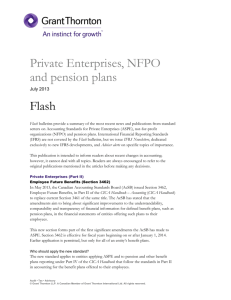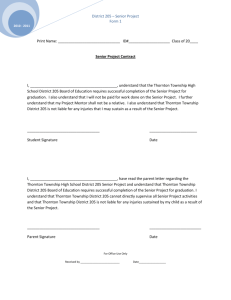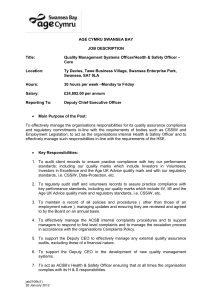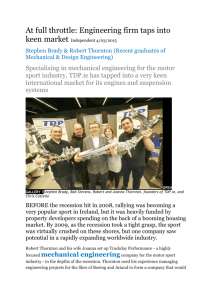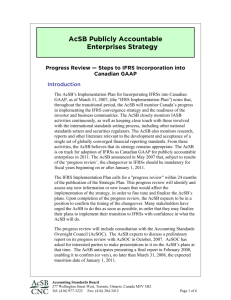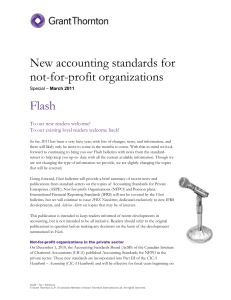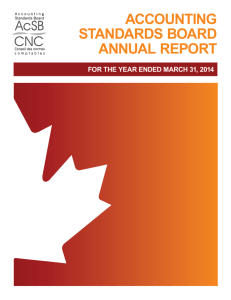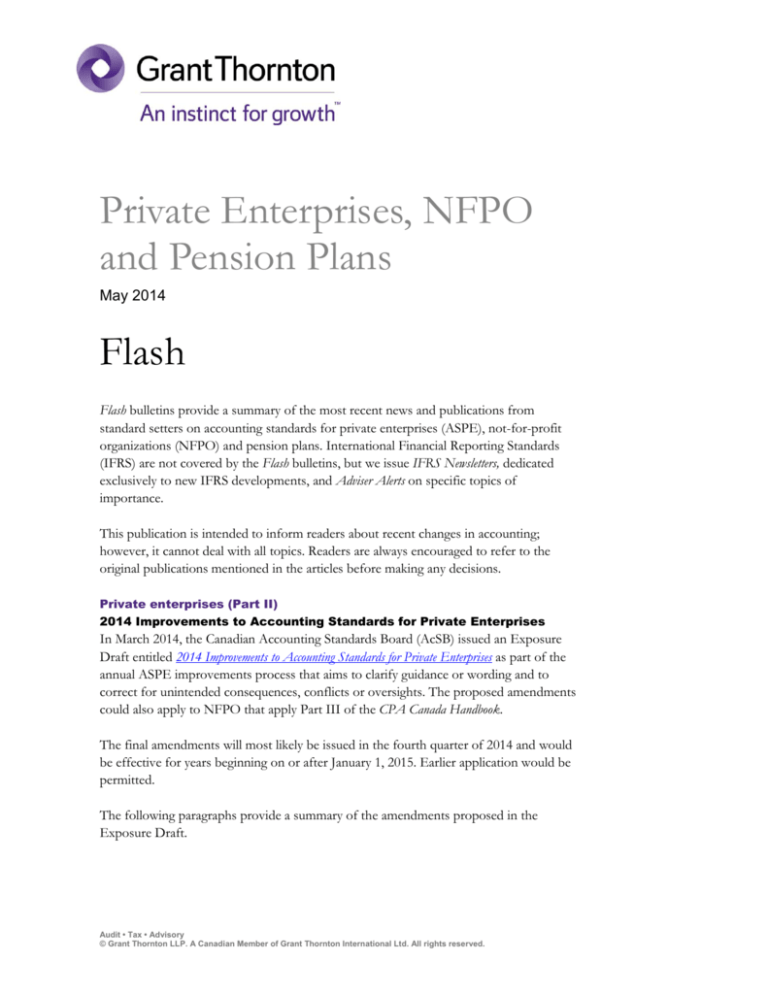
Private Enterprises, NFPO
and Pension Plans
May 2014
Flash
Flash bulletins provide a summary of the most recent news and publications from
standard setters on accounting standards for private enterprises (ASPE), not-for-profit
organizations (NFPO) and pension plans. International Financial Reporting Standards
(IFRS) are not covered by the Flash bulletins, but we issue IFRS Newsletters, dedicated
exclusively to new IFRS developments, and Adviser Alerts on specific topics of
importance.
This publication is intended to inform readers about recent changes in accounting;
however, it cannot deal with all topics. Readers are always encouraged to refer to the
original publications mentioned in the articles before making any decisions.
Private enterprises (Part II)
2014 Improvements to Accounting Standards for Private Enterprises
In March 2014, the Canadian Accounting Standards Board (AcSB) issued an Exposure
Draft entitled 2014 Improvements to Accounting Standards for Private Enterprises as part of the
annual ASPE improvements process that aims to clarify guidance or wording and to
correct for unintended consequences, conflicts or oversights. The proposed amendments
could also apply to NFPO that apply Part III of the CPA Canada Handbook.
The final amendments will most likely be issued in the fourth quarter of 2014 and would
be effective for years beginning on or after January 1, 2015. Earlier application would be
permitted.
The following paragraphs provide a summary of the amendments proposed in the
Exposure Draft.
Audit • Tax • Advisory
© Grant Thornton LLP. A Canadian Member of Grant Thornton International Ltd. All rights reserved.
Flash – May 2014
2
Section 3462 Employee Future Benefits
Section 3462 would be amended to clarify that the option to use a funding valuation for
unfunded defined benefit plans can only be applied by entities that have at least one
funded defined benefit plan.
Section 3856 Financial Instruments
The AcSB proposes to amend Section 3856 to specify
how to account for the hedging item in the hedge of an anticipated transaction when
the hedging item matures after the anticipated transaction is recognized and a
reporting period ends between the date the hedged transaction occurs and the date the
hedging item matures; and
that for certain financial assets, such as accounts receivable, whose impairment is
assessed on a group basis, only the amount of the related allowance for impairment is
required to be disclosed and not the carrying amount of the impaired assets.
Future amendments to ASPE
The AcSB is continuing with various amendment projects to ASPE in order to preserve
the quality and credibility of private enterprises’ financial statements.
The following is a summary of the projects for which the AcSB plans to issue a
Discussion Paper or an Exposure Draft by the end of 2014:
Current projects
Summary
Agriculture
This project addresses accounting for biological assets. A Discussion
Paper is expected in the third quarter of 2014.
Redeemable preferred shares
issued in a tax planning
arrangement
This project plans to re-examine the accounting requirements for
redeemable preferred shares issued in a tax planning arrangement in
Section 3856. Issues to be discussed include scope, reclassification
and measurement.
During its March 2014 meeting, the AcSB agreed that redeemable
shares should be classified as a liability and requested further analysis
of presentation issues associated with these shares.
An Exposure Draft is expected in the third quarter of 2014.
Subsidiaries
This project plans to clarify certain issues in accounting for
investments in subsidiaries under the cost method and the equity
method. One of the areas that will be considered is whether the
requirements of Section 1582 Business Combinations should be
applied when an entity accounts for an investment in a subsidiary
using either the cost or the equity method. An Exposure Draft is
expected in the third quarter of 2014.
Consolidations, Joint Arrangements and Investments
In August 2013, the AcSB published two Exposure Drafts, entitled Consolidations and Joint
Arrangements and Investments, a summary of which is provided in the December 2013 Flash
bulletin. In March 2014, the AcSB approved the issuance of Sections 1591 Subsidiaries and
Audit • Tax • Advisory
© Grant Thornton LLP. A Canadian Member of Grant Thornton International Ltd. All rights reserved.
Flash – May 2014
3056 Joint Arrangements as well as amendments to Section 3051 Investments. Section 1591
will replace Section 1590 Subsidiaries and Accounting Guideline 15 (AcG-15) Consolidation
of Variable Interest Entities, while Section 3056 will replace Section 3055 Interests in Joint
Ventures. The final versions of the new standards are expected to be released into the
CPA Canada Handbook in the third quarter of 2014 and are expected to be effective for
fiscal years beginning on or after January 1, 2016. Earlier application would be permitted.
Some significant amendments that will be made to ASPE with respect to these projects
are summarized as follows
Section 1591 would provide guidance to determine whether an enterprise controls
another entity through mechanisms other than voting rights associated with a majority
shareholding;
under Section 3056, the definitions of jointly controlled operations, jointly controlled
assets and jointly controlled enterprises would remain unchanged, however, the
accounting policy options available would be amended as follows
jointly controlled assets and operations
The method of accounting for jointly controlled assets and operations would be
similar to the proportionate consolidation method currently used under
Section 3055 except that the proportion of the assets, liabilities, revenues and
expenses to be recognized would be based on relevant facts and circumstances in
the contractual arrangement and not solely on the investor’s percentage ownership.
jointly controlled enterprises
Investors would have three accounting policy choices to account for interests in
jointly controlled enterprises:
1. Account for all interests using the equity method;
2.
3.
Account for all interests using the cost method; or
Undertake an analysis of these interests to determine if the interests represent
an interest in individual assets and liabilities or an interest in the net assets of
the joint arrangement. If the investor determines that the interests represent
interests in individual assets and liabilities, the investor would be required to
recognize its share of those assets and liabilities and of the revenue and
expenses. Alternatively, for those interests determined to represent interests in
the net assets of a jointly controlled enterprise, the investor would be required
to account for its interests using the equity method.
Some of these projects could also affect the financial statements of NFPO that apply
Part III; therefore, these organizations should keep abreast of the proposed amendments.
For more information on ASPE amendments, go to the Financial Reporting & Assurance
Standards Canada website.
Audit • Tax • Advisory
© Grant Thornton LLP. A Canadian Member of Grant Thornton International Ltd. All rights reserved.
3
Flash – May 2014
Private Enterprise Advisory Committee
The Private Enterprise Advisory Committee (the committee) was established by the
AcSB to assist the AcSB in maintaining and improving ASPE and advise when nonauthoritative guidance is needed with respect to the standards. The committee’s most
recent meetings were held on December 10, 2013, February 24, 2014 and April 3, 2014.
The following paragraphs summarize certain topics discussed at these meetings that have
not been discussed elsewhere in this edition of the Flash bulletin.
Redeemable preferred shares issued in a tax planning arrangement
In April 2014, the committee discussed presentation requirements related to the
recognition of redeemable preferred shares issued in a tax planning arrangement as a
liability, a decision made by the AcSB in its March 2014 meeting. The liability would be
measured at fair value on initial recognition. The committee recommended to the AcSB
that the resulting debit be presented as a separate component of equity that would be
reclassified to retained earnings as the preferred shares are redeemed. The committee also
recommended disclosure of a description of the transaction that resulted in the separate
component of equity. In May 2014, the AcSB tentatively approved the committee’s
recommendations.
Review of US GAAP for private company amendments
The committee reviewed recent updates to the United States generally accepted
accounting principles (US GAAP) for private companies issued by the US Financial
Accounting Standards Board. The committee agreed to recommend that the AcSB
undertake a project to consider possible changes to the current accounting for goodwill.
According to the new requirements under US GAAP, private companies have the option
to amortize goodwill on a straight-line basis over a maximum period of 10 years.
2014 annual improvements
The committee discussed various items for inclusion in the 2014 annual improvements
project. The items discussed that were included in the Exposure Draft are summarized in
the first article in this edition of the Flash bulletin. The items that were not included are
summarized below:
Financial instruments—Use of the fair value election option
Questions have been raised as to whether the fair value election option in Section 3856
can be used for the subsequent measurement of financial instruments that were initially
measured in accordance with Section 3840 Related Party Transactions. The committee
agreed that the fair value option can only be applied if the financial instrument is
initially measured at fair value.
Related party transactions—The interaction of Sections 1582 and 3840
Section 3840 requires the accounting for a business transferred between two
enterprises under common control to be in accordance with Section 1582 when the
transfer must be accounted for and measured at the exchange amount. The committee
noted that the interaction of Sections 1582 and 3840 is not always clear, and requested
Audit • Tax • Advisory
© Grant Thornton LLP. A Canadian Member of Grant Thornton International Ltd. All rights reserved.
4
Flash – May 2014
additional research on the matter. The committee will continue its discussions on this
topic at a subsequent meeting.
Taxes payable method
The committee discussed two issues related to the application of the taxes payable
method in Section 3465 Income Taxes:
The first issue deals with the impact this method has on the accounting for a
business combination in accordance with Section 1582. Section 1582 requires the
fair value of an acquired item to reflect its tax base when using the taxes payable
method. The committee noted that a fair value calculation would take into account
the timing of when temporary differences can be claimed. The committee agreed
that professional judgment should result in appropriate accounting. The committee
also noted that depending on whether the acquirer applies the taxes payable method
or the future income taxes method to account for income taxes, the amount of
goodwill recognized would be different simply because the fair values of assets
recognized in an acquisition are different depending on the tax method used. This is
considered to be an acceptable consequence of goodwill being a residual amount.
The second issue related to how an entity accounts for the purchase of tax losses
that is not part of a business combination when using the taxes payable method
rather than the future income taxes method. The committee noted that the
acquisition of tax losses falls within the scope of Section 3465 and that the taxes
payable method precludes recognition of an asset related to future income tax
recoveries.
Employee future benefits
The committee discussed various application issues when an entity uses an actuarial
valuation for funding purposes to measure the obligation for a defined benefit plan in
accordance with Section 3462.
An entity may elect to measure its defined benefit obligation using a funding
valuation for its defined benefit plans at the end of the year in which Section 3462 is
adopted but it may not have a funding valuation for the comparative period
presented. The committee agreed that a “roll-back” of the funding valuation would
be consistent with the “roll-forward” technique in Section 3462 as well as with the
transitional provisions that implicitly use a “roll-back.”
If a funding valuation is used to measure a defined benefit obligation, Section 3462
requires that “the most recently completed” valuation be used. The committee
discussed the significance of these terms and noted that the “Background
Information and Basis for Conclusions” document for Section 3462 discusses the
AcSB’s rationale in this regard. The AcSB did not intend that entities delay issuing
financial statements to wait for a valuation report or accelerate their process of
obtaining a funding valuation. Entities would use the most recent actuarial valuation
at their disposal when preparing their financial statements.
For more information on the committee, go to the Financial Reporting & Assurance
Standards Canada website.
Audit • Tax • Advisory
© Grant Thornton LLP. A Canadian Member of Grant Thornton International Ltd. All rights reserved.
5
Flash – May 2014
Not-for-profit Organizations (Part III)
Many of the topics covered in section “Private Enterprises (Part II)” may also be relevant
for NFPO that apply Part III of the CPA Canada Handbook.
Since the publication of the December 2013 Flash bulletin, no significant standard-setting
activities were undertaken in Canada with regards to NFPO accounting.
In 2013, the AcSB and the Public Sector Accounting Board issued a Statement of
Principles entitled Improvements to Not-for-Profit Standards proposing to improve accounting
standards for NFPO in the private and public sectors that currently apply either Part III
of the CPA Canada Handbook or the CPA Canada Public Sector Accounting Handbook
(including the PS 4200 series of sections). The topics of discussion in the Statement of
Principles are
contributions,
tangible capital assets,
intangibles assets,
exemption from tangible and intangible capital assets recognition for smaller NFPO,
works of art, historical treasures and similar items,
controlled and related entities, and
financial statement presentation.
In March 2014, the AcSB were presented with a summary of the comments received
regarding the Statement of Principles and, in May 2014, the AcSB began deliberating
these comments.
For more information on the Statement of Principles, refer to the July 2013 Flash bulletin.
Pension Plans (Part IV)
Since the publication of the December 2013 Flash bulletin, no standard-setting activities
were undertaken in Canada with regards to pension plan accounting.
Audit • Tax • Advisory
© Grant Thornton LLP. A Canadian Member of Grant Thornton International Ltd. All rights reserved.
6
About Grant
Thornton in Canada
Grant Thornton LLP is
a leading Canadian
accounting and
advisory firm providing
audit, tax and advisory
services to private and
public organizations.
Together with the
Quebec firm Raymond
Chabot Grant
Thornton LLP, Grant
Thornton in Canada
has approximately
4,000 people in offices
across Canada. Grant
Thornton LLP is a
Canadian member of
Grant Thornton
International Ltd,
whose member firms
operate in close to 100
countries worldwide.
The information in this
publication is current
as of June 4, 2014.
We have made every
effort to ensure
information in this
publication is accurate
as of its issue date.
Nevertheless,
information or views
expressed herein are
neither official
statements of position,
nor should they be
considered technical
advice for you or your
organization without
consulting a
professional business
adviser. For more
information about this
topic, please contact
your Grant Thornton
adviser. If you do not
have an adviser,
please contact us. We
are happy to help.

